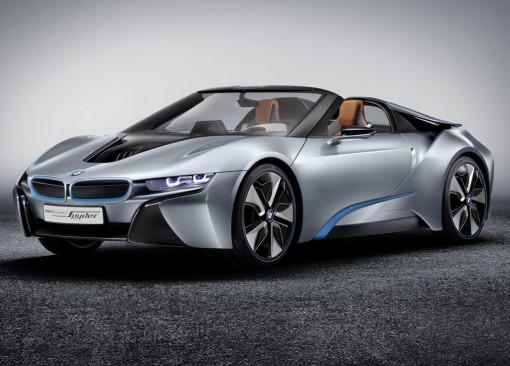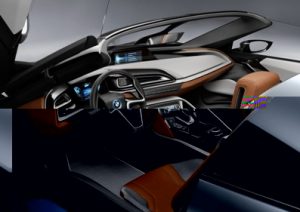Itsy bitsy Spyder spouts lots of technology

JUST as car fans have stopped drooling over BMW’s i8 Concept, they go and whet the appetite yet again!
The German car giant has unveiled the i8 Concept Spyder, the third vehicle in its sub-brand, following on from the i3 Concept and the i8 Concept.
The Spyder is closely related to the original i8 Concept, but this car is very much a two-seater and has a shorter wheelbase. It also comeds with upward swivelling, windowless doors. There is extra equipment fitted including, wait for it, a pair of electric scooters, which fit neatly under a transparent tailgate!
Underneath the athletic and futuristic exterior skin, the i8 Spyder is as advanced as its coupe relation, and is also built around the innovative LifeDrive architecture, which is underpinned by lightweight, modular construction. BMW’s LifeDrive joins together the various independent functional units of the vehicle in the most efficient way possible.
The Spyder’s occupants sit in a very light but immensely strong carbon-fibre-reinforced plastic (CFRP) cell, while the various Drive modules (mainly constructed from aluminium components) are those of an operational nature — powertrain, chassis and the safety structures. So successful is this approach that the additional weight of the high-output Hybrid drivetrain has been completely cancelled out.
A further example of the LifeDrive concept is the housing of the car’s lithium ion batteries in an ‘energy tunnel’ that joins the front and rear axles, thereby maintaining a low centre of gravity and ensuring BMW’s trademark 50:50 weight distribution.
The bold, futuristic design illustrates the dynamic and lightweight character of the vehicle, with its traditionally sporty proportions of a wide but low body, minimal overhangs and an aggressive stance. Large body panels and distinctive aerodynamic elements such as the spoiler lips, Air Curtains and aero flaps are as functional as they are visually expressive.
The new upward-opening doors pivot forward around the axis of the A-pillar, giving the i8 Concept Spyder a particularly distinctive appearance with them open. A two-section roof is planned for when the weather is less favourable. The cockpit is designed around a three-layer composition, with the interlocking lines and surfaces complementing the style of the exterior. The ‘off-white’ outer layer is the supporting structure; the inner layer the ‘comfort’ portion featuring the seats and storage, while the ‘technical’ layer that includes the steering wheel and information display is the third segment.

Drivers have three screens from which to access information: The twin ellipses of the instrument cluster, the central information display and the climate display. The cluster has a digital speedometer and an efficiency display, giving information on how much energy the driver is currently using or recuperating, as well as navigation details and fuel range. In the ECO PRO mode that maximises efficiency this ellipse turns blue: In sport mode it glows orange.
The 8.8-inch central screen displays a wide range of information from the status of the hybrid system to navigational data and connectivity functions. This is particularly important given the advanced suite of driver assistance systems found in the new i8 Concept Spyder, such as the camera-based proactive collision warning feature, park assistant and traffic jam assistant.
By using a smart phone, the driver can find where his vehicle is parked with CarFinder; show nearby charging stations; allow batteries to be charged at pre-determined times and stay informed of the vehicle’s status. Even the interior can be pre-warmed on a cold morning. A plug-in hybrid, the Spyder is powered by an eDrive drivetrain combining a high performance electric motor with a turbocharged, three-cylinder petrol engine.
The lithium Ion batteries are stowed centrally for the benefit of weight distribution, and can be charged quickly from a domestic power socket. The i8 Concept Spyder uses a 131hp electric motor to power the front axle, and a 223hp turbocharged three-cylinder engine to power the rear axle. Both have been developed in-house by BMW.
With its lightweight construction the combined power output of 354hp propels the Spyder from zero to 62mph in just 5.0 seconds and on to an electronically limited top speed of 155mph, yet delivers an outstanding combined fuel consumption of 94mpg. The electric motor gets its energy from the car’s lithium ion batteries and can be fully charged via a domestic plug socket in under two hours. The Spyder has a range of 19 miles running on electric power alone, while a high voltage generator hooked up to the combustion engine can generate additional power if needed and store it in the battery.
Due to the arrangement of the power sources, the Spyder can run in front-wheel, rear-wheel or all-wheel drive, the vehicle’s electronics deciding on the optimum configuration depending on the situation.
